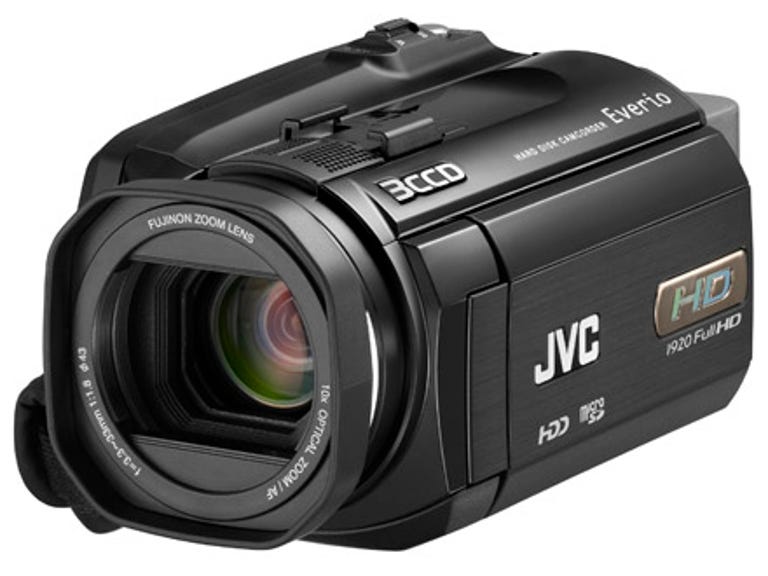 Why You Can Trust CNET
Why You Can Trust CNET JVC Everio GZ-HD6 review: JVC Everio GZ-HD6
In isolation the HD6 is a good camera, however, on almost every turn it is outpointed by its Sony counterpart, the HDR-SR12.
Design
JVC's GZ-HD6 high-definition camcorder is not a bad looking device. This is partially because of its piano black trimmings that adorn the LCD cover, as well as the top of the camera. We're not immune to charms of shiny black surfaces, they certainly look good on your desk or in your kit bag, but no sooner have we picked them up do they become festooned with enough fingerprint smears to make a three-year-old happy. The camera's nice, if somewhat blocky, lines are also ruined by the battery pack that protrudes out the back.
The Good
The Bad
The Bottom Line
As is almost universal, the zoom rocker and photo shutter are sited at the rear of the camera's top face and are operated by your index finger. Below these controls, on the back of the camera, are the video record button and the on/off/mode dial, which are both operated by one's thumb. On the left-hand edge of the flip-out 2.8-inch LCD is a thumbstick which, in addition to being a menu navigation device, allows for easy access to four key functions: focus mode, auto-exposure program, night mode, and quick exposure. Flanking the thumbstick are two buttons: the one above said stick shows the hard-disk battery status; while the one below allows the thumbstick to change key settings, like brightness, shutter speed, aperture, and white balance.
Controls which are less likely to be used when you're setting up to record, or when you're recording, are banished to the LCD screen's hiding hole. These include the menu, auto mode, event type, and playback buttons. Lumped in, unfortunately, with this lot is the focus assist button, which turns the LCD screen into a black and white display with the in focus areas highlighted in blue. Another gripe is the menu system, which takes what feels like an eternity to scroll through; it makes getting to settings like XV Colour and recording quality an awful chore.
Features
The HD5 and the HD6 share almost identical spec sheets; the more expensive HD6 is differentiated by its piano black trim (silver's the predominant colour on the cheaper model), larger hard-disk (120GB versus 60GB) and the inclusion of a lens hood and headphone jack. Both feature a 10x optical zoom lens with optical image stabilisation and three CCD image sensors — one each for red, green and blue. There's a microphone input but no hot shoe; instead there's a cold shoe, which means that accessories, such as microphones, will require their own power, as well as cables. As is the vogue, the HD5 and HD6 are hybrids, meaning that they can record video, as well as photos, to removable flash memory — in this case microSD, although there's no card included — as well as hard-disk.
Hidden under various rubber doors are a variety of video outputs. Hallelujah! Although JVC hasn't thrown in a cable, it has included a full-size HDMI port instead of the mini-HDMI slot usually fitted to high-def camcorders, cables for which are expensive and hard to find. There are also component- and composite-out jacks — the requisite cables for which are supplied — although using the composite out should be avoided because of its rather fuzzy output.
Performance
About six seconds after a cold start the HD5/HD6 is ready to start shooting. Footage shot on HD5/HD6 is sharp and clear, with nice natural colour, although its low light performance definitely has room for improvement. Although the JVC records at 50 interfaced frames per second, it then upscales it to 50p through its HDMI port. So far so good, but the fly in the JVC's ointment is the company's adherence to the MPEG2 TS file format. Other high-def camcorder makers — namely Panasonic, Sony and Canon — use the AVCHD format, which is slowly gaining support from video-editing software suites. MPEG2 TS on the other hand is an almost forgotten format child wandering aimlessly in a windswept electronic steppe. The MPEG2 TS format effectively locks you into the software set supplied with the camera which, although painfully slow to load, is sufficient for non-demanding edits, although aspiring George Millers should stay well clear of the JVC.
Sadly, especially considering that they're JVC's top-of-the-range camcorders, both the HD5 and HD6 miss out on an electronic viewfinder. This makes hand holding the camera for long periods an exceptionally tiring experience. Compounding issues is the lack of shooting priority, meaning that when you're fiddling around with the camera's menu system you'll have to wend your way out before hitting the record button. JVC also does its best to discourage you from taking photos with the HD5/HD6 with its insistence that you switch to camera mode first which, by the way, rules out taking photos while filming. The still's low resolution (1.5-megapixel) and poor quality are the final nail in that coffin.
Conclusion
In isolation the HD6, as well as its cheaper sibling, the HD5, are good cameras. However, on almost every turn they are outpointed by its Sony counterparts, the SR12 and SR11, respectively.


